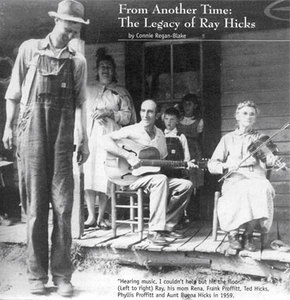

Books written about the famous storyteller include "From Another Time: The Legacy of Ray Hicks" by Connie Regan-Blake.
JOHNSON CITY, TN – The town of Beech Mountain in North Carolina has changed dramatically since East Tennessee State University faculty members Dr. Thomas G. Burton and the late Professor Jack Schrader began filming in Southern Appalachia in the 1960s.
In the mid-1970s, Burton, who has since retired, and Schrader turned their attention to Appalachian storyteller Ray Hicks and his family and friends. Two of their films, "A Film about Ray Hicks" and "Buna & Bertha," have been packaged along with earlier footage recorded by Burton and his ETSU Department of English colleague, the late Professor Ambrose Manning, into a newly released DVD entitled "Ray Hicks and Other Beech Mountain Folks." Each film and the additional footage are introduced by Burton in an informative, entertaining hour-long presentation.
According to Burton, "There are just a lot of interesting stories and from a lot of interesting people around Beech Mountain. And I think Ray and Buna and Bertha and Stanley and Hattie - they're some of the most interesting people up there, or were, on the Beech."
Standing nearly seven feet tall, Ray Hicks spoke a dialect of English that retained much of the vocabulary and phrasing of earlier immigrants to the region. His distinctive way of speaking is a particularly interesting aspect of "A Film about Ray Hicks." Because of that speaking style, Robert McNeil featured Hicks in the PBS series "The Story of English."
Known primarily for his storytelling, particularly for a group of stories known as Jack Tales, Hicks was the first storyteller invited to what eventually became known as the National Storytelling Festival in Jonesborough. Hicks died in 2003, but he remains an iconic figure in the storytelling revival movement. In fact, upon entering the International Storytelling Center the first large photograph one notices is Ray Hicks telling a story to festival-goers.
When asked if he "discovered" Ray Hicks, Burton explained that while he did not "discover" Hicks, he did introduce him to Jimmy Neil Smith, the founder of the National Storytelling Festival. Over the ensuing years, Ray was featured in documentaries, profiled by the New Yorker magazine, and recognized by the Smithsonian Institution. Both he and his cousin, Stanley Hicks, received the National Heritage Fellowship Award from the National Endowment for the Arts.
Burton offers the viewer "behind-the-scenes" anecdotes that enhance the original footage. For example, Burton talks about how Stanley Hicks and Hattie Presnell, in their own inimitable way, surprised Burton and Manning while filming a segment on how to make mountain moonshine. Burton also introduces earlier footage of Stanley Hicks seeing the "Gorilla Man," or "Bigfoot," also known as "Sasquatch."
Produced by the Archives of Appalachia, a unit of the Center for Appalachian Studies and Services at ETSU, the DVD can be watched straight through or scene-selected by either archival footage or Burton's interviews. As such, the DVD can be a valuable teaching tool for classrooms and libraries, as well as an entertaining film for personal collections.
As Amy Collins, director of the Archives of Appalachia, states, "The Archives' commitment to serving the community extends to making its treasures available to a new generation. This DVD captures the essence of Appalachia in a format that can be used by teachers, students, researchers and the public in innovative ways."
"Ray Hicks and Other Beech Mountain Folks" can be purchased at the International Storytelling Center and Gift Shop in Jonesborough or online at www.etsustore.com. For more information about the DVD, contact the Archives of Appalachia at (423) 439-4338.